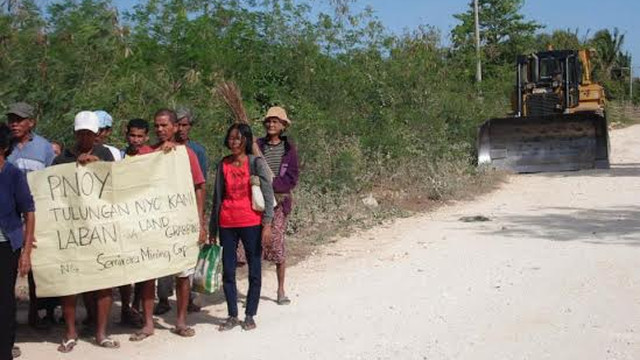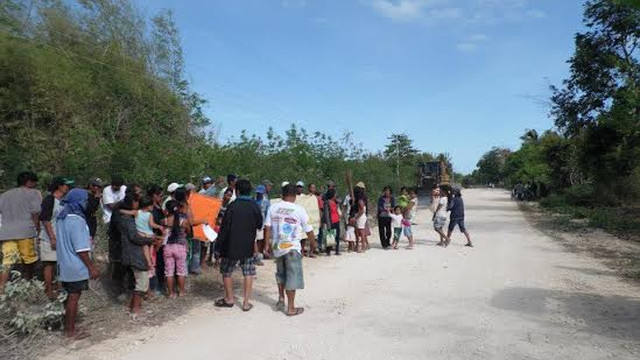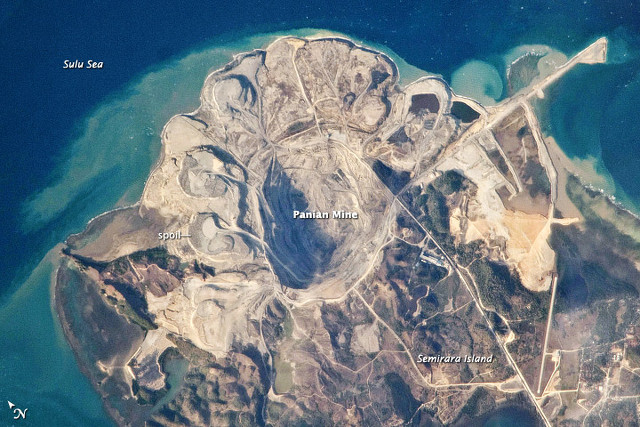 ATTEMPTED DEMOLITION. The locals of Poocan in Semirara Island, Caluya town in Antique oppose the attempted bulldozing of their ricefields. All photos from PAKISAMA
ATTEMPTED DEMOLITION. The locals of Poocan in Semirara Island, Caluya town in Antique oppose the attempted bulldozing of their ricefields. All photos from PAKISAMA
MANILA, Philippines – Farmers have barricaded their rice fields in Sitio Poocan in Semirara Island, Antique province, after Semirara Mining Corporation (SMC) personnel tried to bulldoze their crops on Tuesday, February 25.
Two trucks, one bulldozer, and 4 security guards of the DMCI-owned company tried to enter the village at around 4:30 pm, said Theo Mateo, a member of Pakisama (Pambansang Kilusan ng mga Samahang Magsasaka), an NGO that works with fishermen and seaweed farmers in Semirara Island.
The farmers were told by the guards that the bulldozing was ordered by Caluya Mayor Genevieve Lim-Reyes, who plans to turn the land into a relocation site for around 100 families from Sabang, a nearby village, where a waste facility for their coal power plant will allegedly be built.
As of posting Wednesday, the bulldozer is parked outside the rice fields and is being watched by a guard. An SMC assistant administrator who did not wish to be named said they are awaiting orders from the mayor.
Rappler texted Lim-Reyes for her statement but received no reply.
Around 29 households or 70 people will be affected if the demolition is given the go signal. Many of them are farmers who have been tilling the rice fields for more than 30 years.
"Dito na kami lumaki at tumanda. Hindi kami papayag na basta-basta nila kami paaalisin (We grew up here and grew old here. We won't allow them to make us leave)," said village leader Angie Ysug.
Watch this report below.
Lim-Reyes had apparently visited the village weeks ago to ask the locals to voluntarily give up their rice fields so that the relocation of Sabang families could take place, but the locals were not told that it was a done deal.
"The families have received no formal eviction notice, no offer of compensation, and no notice that a process to buy the land was under way," said Bernardo Caluag, Sabang Poocan Farmer and Fishing Association (SAPOFFA) president.
 BARRICADE. Poocan residents form a barricade to stop bulldozing activities reportedly ordered by the mayor
BARRICADE. Poocan residents form a barricade to stop bulldozing activities reportedly ordered by the mayor
The farmers suspect that the relocation of the 100 families in Sabang is to give way to a waste facility for SMC's 15-megawatt coal-fired power plant in another part of the island. (READ: Court blocks Palawan DMCI coal plant)
A waste tailing pond is a facility in which coal ash – a substance left over after the burning of coal – is dumped and stored. Coal ash may contain hazardous chemicals like arsenic, mercury, and lead, which can seep into soil and contaminate the environment.
"A tailings pond is supposed to act like a filter to extract the harmful tailings from water before the water gets dumped into the sea. But if not built well, the tailings can spill and leak into the environment," said Lory Tan, CEO of Worldwide Fund for Nature Philippines.
Project of the mayor
SMC admitted to Rappler that the bulldozing group was dispatched by their company but they clarified it was the project of the mayor.
"This is a project of the mayor. It will be a relocation area. SMC will help build houses for 130 families," said the assistant administrator who spoke to Rappler on the phone but withheld his name.
When asked if the relocation was to make way for a SMC waste tailings pond, he replied, "I am not the right person to answer that."
However, he said the "joint project" was part of SMC's corporate social responsibility program and that the farmers who live on the land are just squatting.
The waste tailing pond to be built allegedly in Sabang will occupy 3 hectares of land that belongs to the local government of Caluya through a deed of donation by the family that used to own the land. Farmer homes, irrigated rice fields, an elementary school, a Department of Social Welfare and Development daycare center, and the town plaza currently sit on the land.
On Sept 18, 2013, Mayor Lim-Reyes reportedly held a dialogue with locals who live there to persuade them to relocate to give way for the tailings pond.
Mining expansion
 BIGGEST PIT. The Panian Mine operated by Semirara Mining Corp is the biggest open-pit coal mine in the Philippines. Image from NASA
BIGGEST PIT. The Panian Mine operated by Semirara Mining Corp is the biggest open-pit coal mine in the Philippines. Image from NASA
SMC is the biggest producer of coal in the country and operates the only open-pit coal mine in the Philippines, according to their website.
Around 90% of all the coal being produced in the country comes from the mine.
SMC was given exclusive rights by the Department of Energy (DOE) to mine coal and conduct explorations in Semirara. Their first Coal Operating Contract (COC) expired in July 2012, but they were able to extend the contract until 2027.
Locals vehemently opposed the expansion of SMC's contract. Last October 22, around 400 locals rallied simultaneously in front of the Semirara village hall and Caluya municipal hall to say no to the mining expansion. Environmentalists all over the country have also critized the government's coal-oriented energy program.
Fishermen and seaweed farmers fear that expansion of coal projects will endanger the marine and land ecosystems in the island which they depend on for their livelihood.
Seaweed farmers, which make up around 30% of the population, are particularly affected.
Farmers say waste from the coal mine that ended up in the surrounding waters of the island has killed many of their carefully tended seaweed plants.
"Seaweed is really interesting because it only survives in clean waters. It's a very good indicator of pollution. As soon as there are any pollutants in the water, it dies or it gets diseased. So there are places in Semirara where people are no longer able to grow seaweed," said Shannon Arnold, Pakisama national fisheries program manager.
Farmers and fishermen report seeing black dust-like particulates in the water ever since the coal pit opened in the 1980s. source
No comments:
Post a Comment